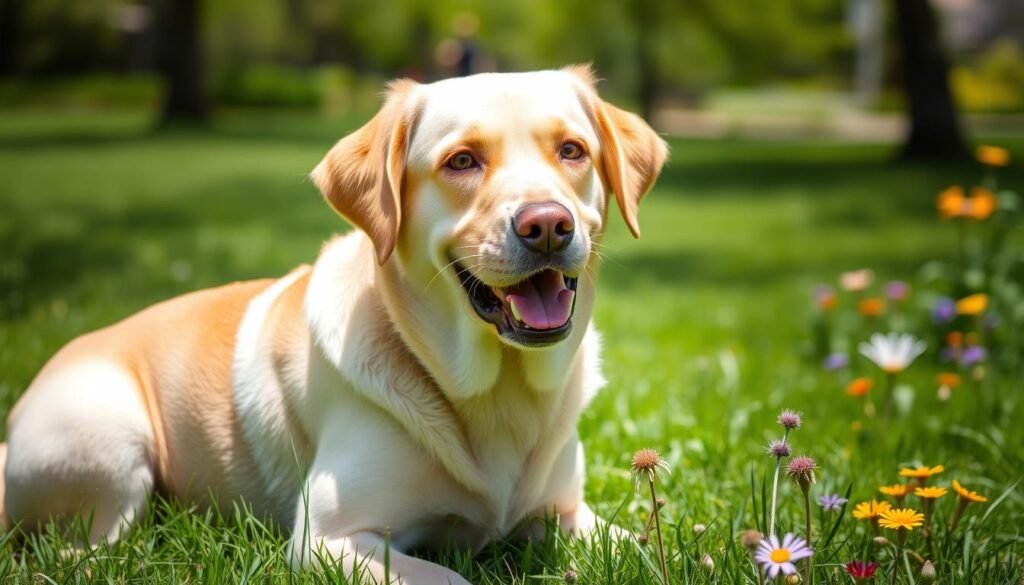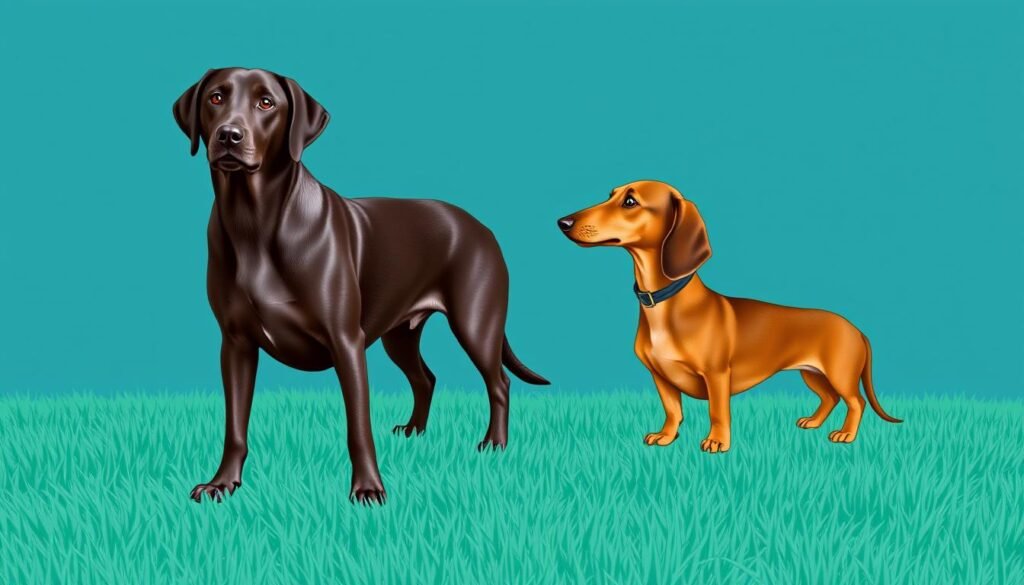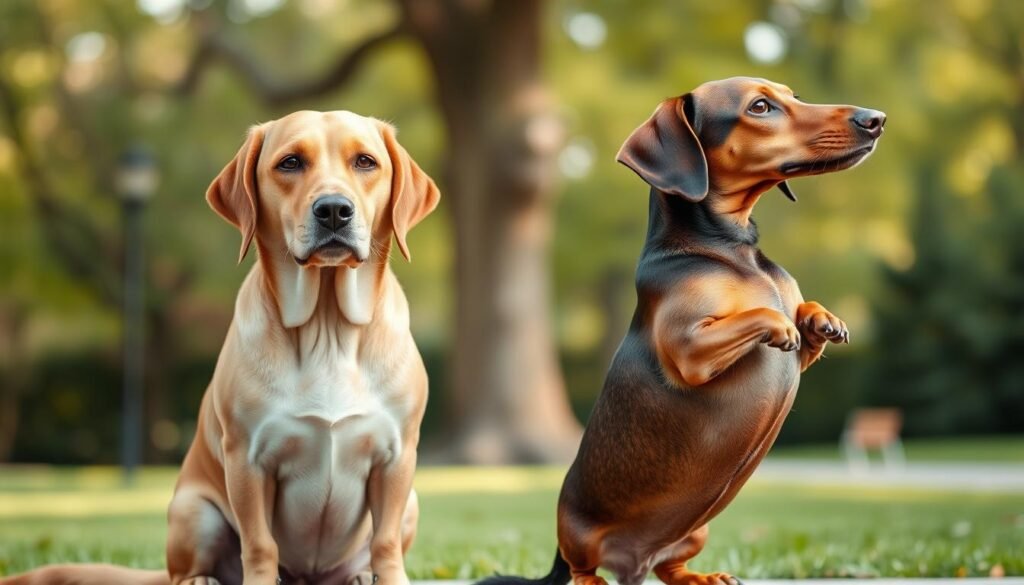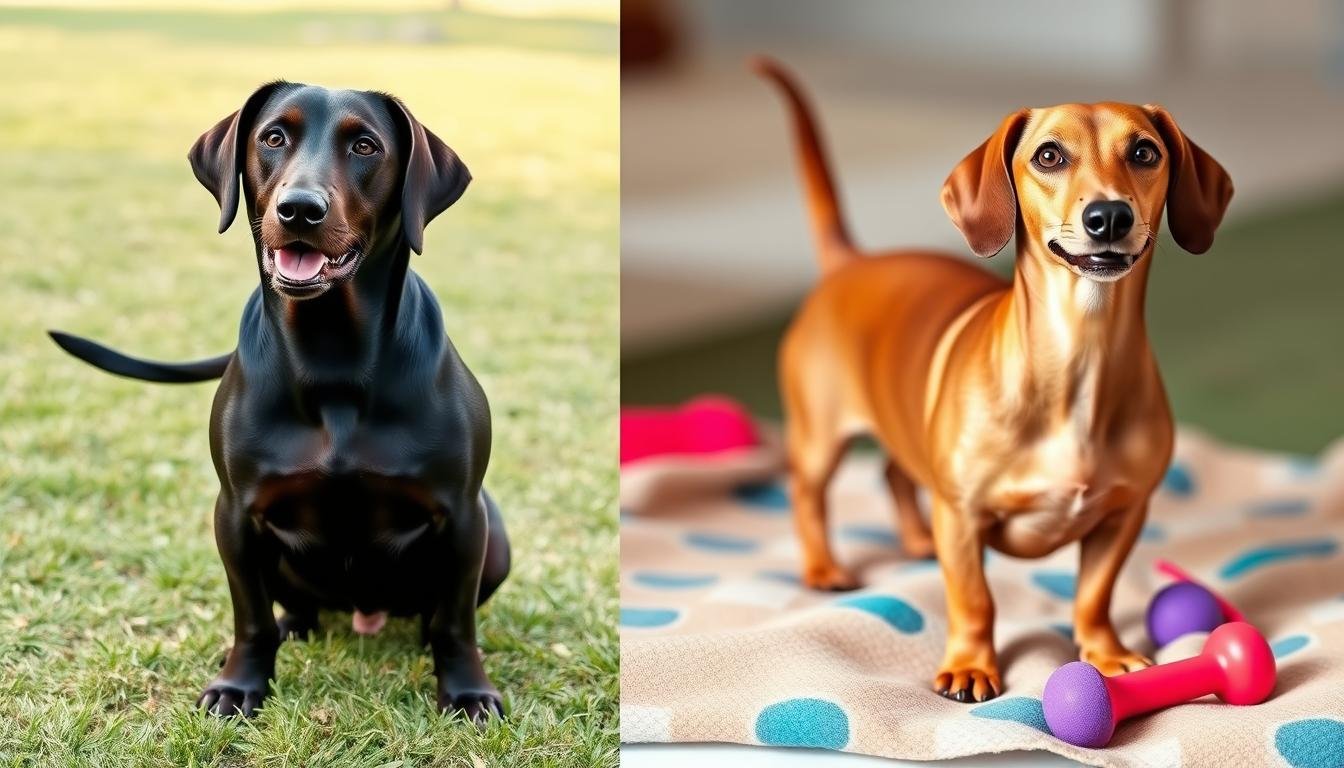Labrador Retrievers vs Dachshunds: Breed Comparison
Did you know Labrador Retrievers are America’s most popular dog breed? Dachshunds rank 13th. These two breeds are very different. They have unique features that attract different pet owners.
Labradors are big and full of energy, weighing up to 75 pounds. Dachshunds are smaller, with standard sizes around 32 pounds. Their size affects where they fit best in your life.
Both breeds have interesting histories and personalities. They are great for families. Knowing their differences helps you choose the right dog for you.
Key Takeaways
- Labrador Retrievers rank 1st in popularity, Dachshunds 13th
- Significant size differences: Labs weigh up to 75 lbs, Dachshunds up to 32 lbs
- Labs are more active and playful compared to Dachshunds
- Dachshunds are better suited for apartment living
- Both breeds are family-friendly with distinct temperaments
- Average lifespan: Labs 11 years, Dachshunds 13 years
- Price range: Labs $1000-$2000, Dachshunds $500-$700
Overview of Labrador Retrievers
Labrador Retrievers are America’s favorite dog breed. They have won hearts for many years. These dogs are great as both hunting companions and family pets. Let’s explore their history and what makes them special.
Origin and History
Labrador Retrievers come from Canada in the 1700s. They were first used for fishing. Soon, they became popular for their many skills.
The American Kennel Club recognized them in 1917. Since then, they’ve been a favorite for 31 years, from 1991 to 2022!

Characteristics and Temperament
Labs are friendly and full of energy. They are medium-large dogs, weighing 55-75 pounds. They stand 22-24 inches tall.
They come in three colors: black, yellow, and chocolate. Their intelligence makes them great for many jobs, like guide dogs and bomb detectors.
As family pets, Labs are wonderful. They are patient with kids, friendly with other dogs, and love to explore. They need about an hour of exercise daily.
They enjoy swimming, hiking, and playing fetch. With the right care, they can live 10-12 years. They bring joy to your home every day.
Overview of Dachshunds
Dachshunds are beloved hunting dogs with a rich history. They have captured the hearts of many dog lovers. These charming pups are known for their unique appearance and spirited personalities. Let’s dive into the world of these adorable sausage-shaped canines.
Origin and History
Dachshunds originated in Germany in the 1400s. Breeders developed these dogs specifically for hunting badgers. Their long, low bodies allowed them to burrow into tunnels effectively. Over time, they became popular as both working dogs and companions.
Characteristics and Temperament
Dachshunds are clever, stubborn, and courageous little dogs. They have a strong prey drive, making them excellent hunting companions. Despite their small size, they’re vigilant watchdogs, often barking at perceived threats. Their adaptability makes them suitable for apartment living.

Size Variations
Dachshunds come in two recognized sizes: standard and miniature. Standard Dachshunds stand 8 to 9 inches tall and weigh 16 to 32 pounds. Miniature Dachshunds are smaller, measuring 5 to 6 inches in height and weighing up to 11 pounds. Both sizes share the breed’s distinctive long body and short legs.
| Size | Height | Weight |
|---|---|---|
| Standard | 8-9 inches | 16-32 pounds |
| Miniature | 5-6 inches | Up to 11 pounds |
With their unique looks and lively personalities, Dachshunds make wonderful companions for various living situations, including apartments. Their moderate energy levels and affectionate nature contribute to their popularity as family pets.
Key Differences in Physical Appearance
Labrador Retrievers and Dachshunds have big size differences and special body shapes. They also have different coat types and colors.
Coat Types and Colors
Labrador Retrievers have a short, dense double coat. They come in black, yellow, and chocolate. Their coats need regular brushing to stay nice.
Dachshunds have three coat types: smooth, wire-haired, and long-haired. They come in many colors and patterns. This makes Dachshunds stand out.
Size and Body Shape
Labs are big dogs, weighing 55 to 80 pounds. They are 21 to 24 inches tall. Dachshunds are smaller, with a long body and short legs.
Dachshunds come in three sizes: standard, miniature, and toy. This means they can weigh 8 to 32 pounds.
| Characteristic | Labrador Retriever | Dachshund |
|---|---|---|
| Size | Large | Small to Medium |
| Weight Range | 55-80 pounds | 8-32 pounds |
| Height | 21-24 inches | 5-9 inches |
| Body Shape | Athletic, muscular | Long, low to ground |
| Coat Types | Short, dense double coat | Smooth, wire-haired, long-haired |
| Color Variations | Black, yellow, chocolate | Various colors and patterns |

These traits make each breed special. They fit different lifestyles. Your choice depends on your home, activity level, and what you like.
Temperament Comparison
Choosing a family-friendly pet means understanding the differences between Labrador Retrievers and Dachshunds. Each breed has its own personality that can change your home life.
Activity Levels
Labrador Retrievers have lots of energy. They need lots of exercise to stay happy. Dachshunds are lively but need less exercise. This affects how well they fit into your life.
Trainability
Labradors are very smart and easy to train. They are among the brightest dog breeds. Dachshunds are clever but can be stubborn. They need more patience and consistent training.
Family Compatibility
Both breeds are great with families but in different ways. Labradors are patient and gentle with kids. Dachshunds are loving but may not like rough play.
| Trait | Labrador Retriever | Dachshund |
|---|---|---|
| Personality | Playful, loving, energetic | Stubborn, courageous, clever |
| Affection Level | Slightly below average | Highly affectionate |
| Barking Tendency | Occasional | Frequent |
| Intelligence Ranking | Outstanding | Average |
Choosing between a Labrador Retriever and a Dachshund depends on your family’s needs. Think about space, exercise time, and training commitment.
Health Considerations for Each Breed
Choosing a dog means knowing about breed-specific health issues. Labrador Retrievers and Dachshunds have their own health concerns. It’s important for potential owners to be aware of these.
Common Health Issues in Labradors
Labradors are usually healthy, but they can face health challenges. Genetic tests show some interesting facts:
- 79.1% of Labs tested clear for Stargardt Disease
- 82.1% tested clear for Exercise-Induced Collapse
- 87.5% tested clear for Progressive Retinal Atrophy
These numbers are good, but they show the need for genetic testing. Labs can also get hip and elbow dysplasia. This can cause mobility problems as they get older.
Common Health Issues in Dachshunds
Dachshunds have their own health concerns because of their body shape:
- Intervertebral Disc Disease (IVDD) is a major concern
- Patellar luxation can affect their knees
- Eye problems are not uncommon
Studies show Dachshunds are more likely to be aggressive than many other breeds. Regular vet visits and proper care can help manage these issues.

| Breed | Common Health Issues | Genetic Test Results |
|---|---|---|
| Labrador Retriever | Hip dysplasia, Elbow dysplasia, Eye problems | 87.5% clear for Progressive Retinal Atrophy |
| Dachshund | IVDD, Patellar luxation, Eye problems | Higher risk for IVDD |
Lifespan and Care Requirements
Knowing how long Labrador Retrievers and Dachshunds live and what they need is key for pet owners. Each breed has its own needs that affect how long they live and how well they live.
Average Lifespan
Labrador Retrievers usually live between 10 to 12 years. Dachshunds, on the other hand, can live up to 16 years. This big difference is important when thinking about caring for a pet for a long time.
Grooming Needs
Labradors have a thick double coat that sheds a lot. They need to be brushed often to keep their coat in check. Dachshunds, with their short, smooth coats, don’t need as much grooming. Both breeds should have their nails trimmed and teeth brushed regularly to stay healthy.
Care Requirements
Labradors need lots of exercise, about 1-2 hours a day. Dachshunds need shorter walks but more often. Both breeds should watch their diet to avoid getting too fat, especially Dachshunds because they don’t get as much exercise.
| Care Aspect | Labrador Retriever | Dachshund |
|---|---|---|
| Exercise | 1-2 hours daily | Regular short walks |
| Grooming | Frequent brushing | Minimal grooming |
| Health Concerns | Hip dysplasia (15%) | IVDD (25%) |
| Feeding (Adult) | Twice daily | Twice daily |
By knowing these differences, you can prepare better for the needs of each breed. This way, you can ensure your dog lives a happy and healthy life.
Ideal Living Conditions
When picking a dog, think about where they’ll live best. Labradors and Dachshunds each have special needs. These needs affect their happiness and health in different places.
Best Environment for Labradors
Labradors need big homes with lots of yard space. They’re full of energy and love to stay active. They enjoy swimming and playing fetch.
Labradors can handle many climates but get hot in extreme weather. Their thick fur makes it hard for them in the heat.
Best Environment for Dachshunds
Dachshunds do well in smaller spaces, perfect for apartments. They don’t need as much exercise as Labradors but still need daily walks and play. They come in standard and miniature sizes, fitting into various homes.
Dachshunds like warmer weather but need care in cold. Their short legs and long bodies make them prone to back problems. Homes with fewer stairs are better for them. A healthy diet is also key to avoid weight issues.
| Breed | Ideal Living Space | Exercise Needs | Climate Preference |
|---|---|---|---|
| Labrador | Large home with yard | High | Moderate |
| Dachshund | Apartment or small home | Moderate | Warm |
Choosing the Right Breed for You
Finding the perfect dog is a big choice. Think about your lifestyle, home size, and how active you are. South West London has many options, from big parks to small apartments.
Factors to Consider
If you love being outdoors and have a big yard, a Labrador Retriever might be perfect. These dogs are smart and need lots of exercise. Places like Morden Hall Park or Wimbledon Common are great for them.
If you live in a small space, a Dachshund or French Bulldog could be better. They do well in apartments but still need to play outside. Remember, all dogs need to exercise and have fun to be happy.
Final Thoughts on Your Ideal Companion
It’s important to match your lifestyle with the right dog. Think about grooming, training, and health issues. In Colliers Wood and South Wimbledon, there are dog-friendly events to meet different breeds.
Before choosing, make sure you’re ready for the responsibilities of dog ownership. This includes vet visits and knowing local dog rules.

